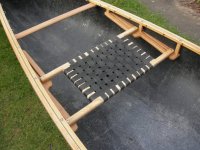The center seat looks like the mount is cantilevered about six inched inside the hull. If the seat to mount joint flexes at all then the torsion has to absorbed by the hull.
Well, the seat to mount joints were not intended to flex at all, though I do take your point. The cantilever is closer to 4" but still....
@Jim Dodd: I agree that the brackets are not so great looking. (Hey, they were a prototype! Even if I stuck to the concept, They are scheduled for a replacement) In practice, seats mounted on the top surface have turned out to be too high when all the weight in the canoe is humans. The original swing rig would have had the seats about 3" lower but I had spacing issues, and could not mount them in all locations.
I have found that the brackets take a lot of space. I intended to remove any that I was not using for a particular trip to save room.
Hull mount blocks are starting to look more attractive, but I'm still concerned about flexibility of arrangements. For reference: In the last week and a half, I've paddled in the following load configurations:
- Solo flatwater+ breeze, 140# paddler, both unloaded and a 50# test load.
- Tandem, 2x 140#, light day gear. Local river/creek with moderate current and occasional riffles. Lots of snags.
- Triple flatwater. 140#, 170#, 180#, no gear. This one was a heavy (over)load, but worked out surprisingly well on sheltered water.
This variety of uses is typical for me (Except the big triple, but that may repeat occasionally)
For those who use their tandem in multiple ways: How do you manage to reconfigure for trimming a load? In all these cases, if I'd had seats locked in a single location, I'm not sure how well things would go.
I'm actually using throwable PFD cushions as temporary seating except for one of the ends, as the lower center of gravity is desirable.
Any thoughts on ideal/close to ideal positioning, or adjustable seating with a hull mount?


